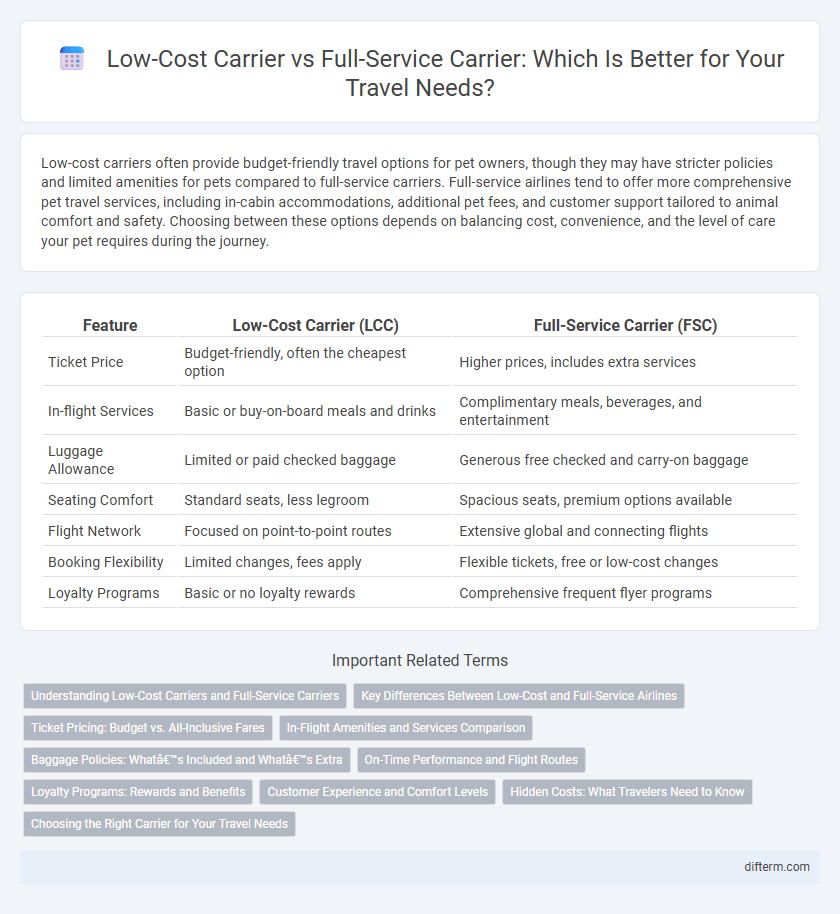Low-cost carriers often provide budget-friendly travel options for pet owners, though they may have stricter policies and limited amenities for pets compared to full-service carriers. Full-service airlines tend to offer more comprehensive pet travel services, including in-cabin accommodations, additional pet fees, and customer support tailored to animal comfort and safety. Choosing between these options depends on balancing cost, convenience, and the level of care your pet requires during the journey.
Table of Comparison
| Feature | Low-Cost Carrier (LCC) | Full-Service Carrier (FSC) |
|---|---|---|
| Ticket Price | Budget-friendly, often the cheapest option | Higher prices, includes extra services |
| In-flight Services | Basic or buy-on-board meals and drinks | Complimentary meals, beverages, and entertainment |
| Luggage Allowance | Limited or paid checked baggage | Generous free checked and carry-on baggage |
| Seating Comfort | Standard seats, less legroom | Spacious seats, premium options available |
| Flight Network | Focused on point-to-point routes | Extensive global and connecting flights |
| Booking Flexibility | Limited changes, fees apply | Flexible tickets, free or low-cost changes |
| Loyalty Programs | Basic or no loyalty rewards | Comprehensive frequent flyer programs |
Understanding Low-Cost Carriers and Full-Service Carriers
Low-cost carriers (LCCs) prioritize affordability by offering basic services with minimal frills, utilizing single aircraft models and secondary airports to reduce operational costs. Full-service carriers (FSCs) provide comprehensive amenities such as in-flight entertainment, meals, and flexible ticket options, often connecting major global hubs. Understanding these distinctions helps travelers choose between budget-friendly fares and enhanced travel comfort based on their preferences and travel needs.
Key Differences Between Low-Cost and Full-Service Airlines
Low-cost carriers (LCCs) offer significantly lower ticket prices by minimizing onboard services and charging extra for amenities such as checked baggage, in-flight meals, and seat selection. Full-service airlines provide inclusive fares with complimentary meals, multiple cabin classes, and extensive frequent flyer programs, catering to travelers seeking comfort and additional perks. Route networks of full-service carriers tend to be broader, often including international and long-haul flights, while low-cost carriers focus primarily on short-haul and point-to-point routes.
Ticket Pricing: Budget vs. All-Inclusive Fares
Low-cost carriers offer budget-friendly ticket pricing by unbundling services, allowing passengers to pay only for the basics and add extras like baggage or meals as needed. Full-service carriers provide all-inclusive fares that cover amenities such as checked luggage, in-flight meals, and seat selection, resulting in higher upfront costs. Travelers choosing between budget and all-inclusive fares should consider their preferences for flexibility versus convenience and total travel experience.
In-Flight Amenities and Services Comparison
Low-cost carriers typically offer basic in-flight amenities, often charging extra for services like meals, seat selection, and entertainment, while full-service carriers include these features as part of the ticket price. Full-service airlines provide more spacious seating, complimentary meals, and a wider range of in-flight entertainment options, enhancing passenger comfort on longer journeys. The contrast in amenities reflects differing business models, with low-cost carriers focusing on affordability and efficiency, and full-service airlines prioritizing passenger experience and comprehensive service.
Baggage Policies: What’s Included and What’s Extra
Low-cost carriers generally include only a small carry-on bag in their base fare, requiring passengers to pay extra for checked luggage and priority boarding, which helps keep initial ticket prices low. Full-service carriers typically offer more generous baggage allowances, including both carry-on and checked bags within the ticket price, along with added services like in-flight meals and seat selection. Understanding these baggage policies is crucial for travelers aiming to balance cost efficiency with convenience and comfort during their trip.
On-Time Performance and Flight Routes
Low-cost carriers often prioritize point-to-point routes with quicker turnarounds, resulting in higher on-time performance compared to full-service carriers that operate hub-and-spoke models with complex connections. Full-service airlines offer extensive global networks and multiple flight routes, providing more options but sometimes facing delays due to the complexity of operations. Passengers choosing between low-cost and full-service carriers should weigh the trade-off between punctuality and route availability based on their travel priorities.
Loyalty Programs: Rewards and Benefits
Low-cost carriers often provide basic loyalty programs with limited rewards focused on discounts and occasional perks, appealing to budget-conscious travelers prioritizing cost savings. Full-service carriers offer comprehensive loyalty programs that include tiered benefits such as priority boarding, lounge access, free upgrades, and extensive partner rewards, enhancing the overall travel experience for frequent flyers. These robust loyalty schemes foster customer retention by delivering added value beyond just ticket price, influencing passenger choice between carrier types.
Customer Experience and Comfort Levels
Low-cost carriers prioritize affordability by offering basic seating and minimal in-flight services, often resulting in reduced legroom and fewer amenities, which can impact overall comfort levels. In contrast, full-service carriers provide enhanced customer experience with spacious seating, complimentary meals, and additional services such as in-flight entertainment and baggage allowance, catering to passenger comfort and convenience. The choice between these carriers depends largely on travelers' preferences for cost savings versus a more comfortable and service-rich journey.
Hidden Costs: What Travelers Need to Know
Low-cost carriers often attract travelers with lower base fares but frequently impose hidden costs such as baggage fees, seat selection charges, and onboard food expenses, which can significantly increase the total price. Full-service carriers typically include checked baggage, meals, and seat assignments in the ticket price, offering more transparency but higher upfront costs. Travelers should carefully compare the full cost of both carrier types to avoid unexpected expenses and choose the best option based on their travel needs.
Choosing the Right Carrier for Your Travel Needs
Low-cost carriers offer budget-friendly fares by eliminating extras such as checked baggage and in-flight meals, appealing to price-sensitive travelers seeking basic transportation. Full-service carriers provide a comprehensive travel experience with amenities like priority boarding, in-flight entertainment, and complimentary meals, ideal for passengers valuing comfort and convenience. Evaluating factors such as travel distance, budget constraints, and desired service levels ensures selecting the right carrier aligns with individual travel needs.
low-cost carrier vs full-service carrier Infographic

 difterm.com
difterm.com